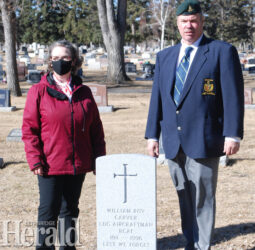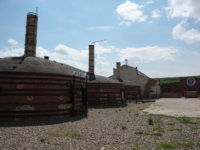New grave markers honour dead veterans
By Dale Woodard on March 18, 2021.
 Yvonne Sugimoto, volunteer with the Last Post Fund, and Glenn Miller, volunteer of the Alberta Branch Last Post Fund, pose at the headstone of veteran William Roy Carver at the Mountain View Cemetary.
Herald photo by Dale Woodard
Yvonne Sugimoto, volunteer with the Last Post Fund, and Glenn Miller, volunteer of the Alberta Branch Last Post Fund, pose at the headstone of veteran William Roy Carver at the Mountain View Cemetary.
Herald photo by Dale WoodardThey will not be forgotten. Now, 17 veterans laid to rest in southern Alberta will also have the proper markings.
The installation of recently installed temporary signage will recognize the graves of veterans who have been approved for Military style markers.
The graves were identified by Alberta branch member of the Last Post Fund, Yvonne Sugimoto, who has researched in finding and identifying unmarked graves of veterans.
Thanks to her efforts over the years, nine markers are on the way for nine veterans in Lethbridge, two in Taber, one in Raymond and five in Fort Macleod along with serveral more in Calgary.
“I’ve been working with the Last Post Fund as a volunteer for about 12 years,” said Sugimoto at a short ceremony Wednesday morning at Mountain View Cemetery honouring the local veterans. “I started because I noticed there were some graves in the field of honour that weren’t marked. I asked the cemetery staff, who put me in touch with Glenn (Miller, volunteer for the Alberta Branch Last Post Fund) and he explained what needed to happen.
“Since then, because these people – men and women – were willing to give their everything, their lives, for our way of life, I wanted them to be remembered.”
Honoured with temporary signage at Mountain View Cemetery is Thomas Marienus Dogterom (1920-1984), Joseph Thomas Patrick Ferguson (1894-1960), Thomas Samuel Hunt (1880-1954), Steven Kravets (1894-1962), John Rufus Lowther (1894-1956), John Dirk Roelofs (1910-1984), Cleason Schweitzer (1889-1951), Samuel Vere (1886-1950) and John Cyrus Wright (1893-1983).
In Taber, Edward Eldon Ellingson (1914-1982) and James Leper Milne (1885-1956) will receive temporary signage, as will Edward Davies (1875-1965) at Temple Hill in Raymond.
At Union Cemetery in Fort Macleod, James Hugh Campbell (1896-1954), George Percy Dixon Ferguson (1893-1929), William E. Ferguson (1883-1962), John Purrier Griffin (1897-1973) and Richard John Sherlock Vandersluys (1910-1993) will also receive signage.
Also recognized Wednesday with headstone that had been recently installed was veteran William Roy Carver (1911-1996).
Standing at the resting place of Lowther, Sugimoto shared his bio.
“He was born in 1894 here in Alberta,” she said. “He is a native son and he died in 1956. He was the last of his family living in Alberta. He was an electrician and he was 24 when he enlisted in 1918. He was just a tiny person. He was five-foot-two. It didn’t matter if you were huge or tiny, these people were willing to fight for our country and we should remember them.”
Sugimoto said the process of identifying the unmarked graves was initially easy.
“I started working with the the ones in the Field of Honour. Then it became more difficult. I started using obituaries and then the death registers became available to us in Alberta and they’re currently available from 1925 to 1970. So the process I’m going through now is very labour intensive. I have a list of everyone buried in the cemetery and I’m going through the death registers and matching up when they died with when they were born. If it looks like they might be in the right age category, then I start looking for their obituaries and military records. Once I’ve got all that together then I submit it to the Last Post Fund for consideration for a headstone.”
The timeframe of identifying some veterans only took a few days, said Sugimoto.
“Others, it has taken eight or nine years to get everything attached and put together. There was one man in the Fort Macleod cemetery and due to his age – he was born in the 1880s – his obituary said he served in World War I. I looked for seven years in World War I under every possible spelling of his name. Finally, one of his family members from Saskatchewan contacted me through Find A Grave and said he served in World War II. Which totally stunned me. But we did find his records in World War 2 and they accepted him because he was a lumberman and he could do what they needed as far as harvesting lumber in Scotland.
“So sometimes it’s a very interesting process and sometimes it’s confusing and time consuming, but overall it’s rewarding because these people do deserve to be remembered.”
No matter how long it takes her, Sugimoto said it’s a fulfilling process.
“I think being able to come down to the cemetery and visit their graves – and I do that every Remembrance Day – and just think about them as people,” said Sugimoto.
“So many of them died alone. Many of them had PTSD and if you’re dying in a foreign country and you’re ill and you have no one that cares about you, it’s important somebody recognizes what you did for your country.”
The Last Post Fund is a not-for-profit organization whose mission is to ensure that no veteran at the time of death is denied a dignified funeral, burial and headstone for lack of insufficient needs, said Miller.
The primary mandate of the Last Post Fund is to deliver the funeral and burial program on behalf of Veterans Affairs Canada. The Last Post Fund is supported by Veterans Affairs Canada and by donations across Canada.
“Since it’s inception, the Last Post Fund has arranged for the funeral and burial of over 150,000 veterans who were financially challenged at the time,” said Miller. “According to Veteran’s Affairs Canada, there remain less than 80,000 World War 2 veterans and Korean veterans. These traditional veterans, as you can imagine, will be soon gone among us.
“According to Veteran Affairs Canada, today there are about 600,000 veterans among us post-Korea and about 225 each year need our service.”
In 1996 the Last Post Fund created the unmarked grave program to ensure all veterans graves are ultimately indentified with a proper military marker, said Miller, adding nearly 3,500 graves have been marked since the program began.
“There remains approximately 2,000 to 4,000 graves that we don’t have marked,” he said. “As a veteran myself, I’ve always been guided by three simple words, Lest We Forget. And in many cases it has been forgotten for whatever reason. So it’s a small step to fix that, honour that and preserve it moving forward. That’s part of our motto at the Last Post Fund and in all our stones at the very bottom ‘Lest We Forget’ is also inscribed.”
-1



